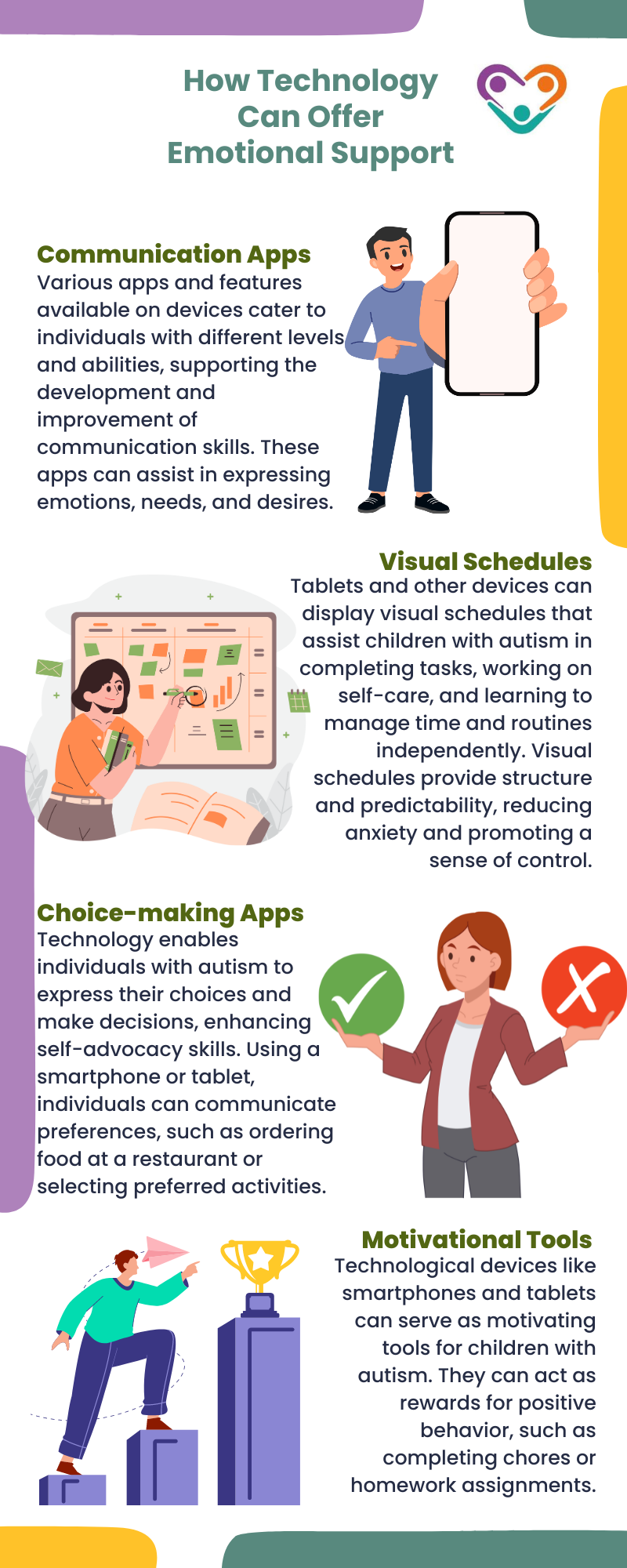The introduction and use of assistive technology (AT) have become increasingly valuable these days to support individuals with autism better. In case you’re wondering, assistive technology for autism encompasses a wide range of tools that can help with learning, communication, and daily functioning.
These tools can range from simple picture boards and worry beads to sophisticated software, apps, and robots.
But how exactly can they benefit autistic individuals? Let’s explore the details further.

Assistive Technology for Autism
Assistive technology for autism is designed to address the unique challenges faced by individuals on the autism spectrum.
As many as 35% of autistic children may be non-verbal or minimally verbal, and virtually all autistic people experience some difficulty with social communication. AT tools provide autistic individuals with an alternative means to communicate their thoughts, needs, and emotions effectively.
The use of technology can greatly enhance communication skills for individuals with autism. Various apps and features available on devices cater to individuals at different levels and abilities. Visual schedules on tablets, for example, can assist children with autism in completing tasks, working on self-care and daily living skills, and learning to manage time and routines independently.
Additionally, technology can empower individuals with autism to express their choices and make decisions. By using smartphones or tablets, they can communicate their preferences at a restaurant or engage in self-advocacy, fostering independence and self-confidence.

Types of Assistive Technology for Autism
Assistive technology plays a vital role in supporting individuals with autism spectrum disorder (ASD) in various aspects of their lives. These technologies can range from low-tech solutions to high-tech innovations, all aimed at enhancing communication, learning, sensory regulation, and overall well-being.
Let’s explore the different types of assistive technology available for individuals with autism.
Low-Tech Solutions
Low-tech assistive technology options for individuals with autism encompass simple tools that can be easily implemented in daily routines. These solutions are often cost-effective and user-friendly, making them accessible to a wide range of individuals.
Here are some common low-tech solutions out there:
- Picture Boards and Cards – These visual aids, including those created in the Picture Exchange Communication System (PECS), use pictures and symbols to facilitate communication and understanding.
- Visual Schedules – Visual schedules help individuals with autism manage their daily routines and tasks by providing a visual representation of activities and their order.
- Worry Beads – Worry beads, also known as fidget tools, can provide sensory stimulation and help with self-regulation and focus.
Mid-Tech Solutions
Mid-tech assistive technology options for autism incorporate the use of electronic devices and software to support communication, learning, and cognitive development. These solutions offer more advanced features and customization options compared to low-tech alternatives.
Here are some good examples:
- Communication Apps – There are a variety of apps available that assist individuals with autism in improving their communication skills. These apps often include features such as picture-based communication boards, text-to-speech capabilities, and customizable communication boards.
- Speech Therapy Apps – Mid-tech solutions also include apps specifically designed for speech therapy, offering interactive exercises and activities to support speech and language development.
High-Tech Solutions
High-tech assistive technology solutions for autism encompass more advanced and innovative options that leverage cutting-edge technologies. These solutions often require specialized equipment and may come with a higher price tag.
A few good examples include:
- Virtual Reality (VR) Therapy – VR therapy utilizes immersive environments to provide autistic individuals with a safe and controlled space for practicing social interactions, managing anxiety, and improving social skills.
- Robots – Robotic companions and therapy aids have shown promise in supporting individuals with autism in areas such as communication, social engagement, and learning. These robots can provide structured interactions and personalized interventions.
It’s important to note that the choice of assistive technology should be based on individual needs, preferences, and abilities. While some individuals may benefit from low-tech solutions, others may require the advanced features and customization options that high-tech options offer.
Finding the right balance and combination of assistive technology tools can greatly enhance the quality of life for individuals with autism.

Importance of Technology for Autistic Individuals
Technology plays a vital role in supporting autistic individuals in various aspects of their lives. Many autistic children have co-occurring conditions such as intellectual disabilities, attention deficit hyperactivity disorder (ADHD), and anxiety disorders, which can create challenges in school and the workplace.
AT can help address these challenges by providing support for learning, executive functioning, and sensory issues.
Video modeling is another effective use of technology for individuals with autism. This visual teaching method involves watching videos on smartphones or tablets to learn various skills. By using video modeling, learning becomes more engaging and effective for individuals with autism.
By harnessing the power of technology and utilizing assistive tools, individuals with autism can overcome barriers, enhance their communication and learning skills, and improve their overall quality of life. As long as technology usage is properly managed, like managing screen time for example, parents and caregivers can use them to their fullest potential.
Emotional Support through Technology
Technology can also provide emotional support to individuals with autism. This way, such technology can help them navigate and express their emotions effectively.
Here are a few ways in which technology can offer emotional support:

By harnessing the power of technology, individuals with autism can find support and tools to regulate their sensory experiences and enhance their emotional well-being.
It’s important to explore and identify the specific sensory and emotional needs of each individual to determine the most effective use of technology for their unique circumstances.
Research continues to shed light on the neurological basis of sensory issues in autism, offering hope for more targeted and effective therapies in the future. By recognizing and addressing sensory processing difficulties, we can improve the quality of life for individuals with autism and their families. If you’re seeking specialized ABA therapy in New Jersey, Indiana, Georgia, and New York, Golden Care offers comprehensive services tailored to meet the unique needs of each individual. Contact us to learn more or book a consultation today.
Sources:
https://app.machined.ai/home?cluster=1716275167061×897146881560019000&tab=clusters
https://www.autismspeaks.org/tool-kit-excerpt/how-technology-can-help
https://reciteme.com/news/assistive-technology-for-autism
https://www.autismparentingmagazine.com/assistive-technology-benefits-with-autism



